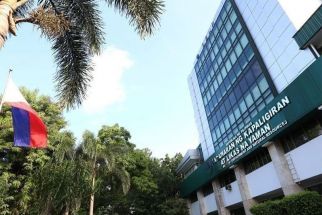How an equally big news drowns out tourism assembly
October 26, 2006 | 12:00am
Undoubtedly, the Western Visayas Tourism Assembly in Iloilo City is the most eye-catching story of Western Visayas. But there are other events and developments that tried to drown out its impact on visitors and dampen its prospective impact on the region.
Of course, nothing could have impacted more on the assembly’s participants from the various parts of Region VI and other areas of the country who joined the officials of provinces and component cities of Western Visayas for Monday’s opening ceremonies at the SM Center.
Tourism Secretary Joseph Ace Durano presided over the ceremonies with regional development chairwoman and Antique Gov. Sally Zaldivar-Perez and Iloilo City Mayor Jerry Trenas welcoming the participants.
And the display booths of various participants attracted hordes of viewers to the SM City exhibit area.
Shoppers also had a heyday selecting items that they could buy and gawking at the various products made mostly of indigenous materials.
But there were the other disturbing distractions. Most of the country’s media practitioners, mostly countryside journalists, made a beeline to Kalibo in Aklan for the Publishers Association of the Philippines Inc. (PAPI) Media Summit from Oct. 26 to 29.
Some 200 working journalists, mostly editors and publishers of rural media, started their trip early to Aklan for the summit.
The theme of the confab is "The Role of the Press in Spotlighting Investment Opportunities for Aklan." President Juan Dayang said the conference coincides with Aklan’s presentation of three major festivals — the Ati-atihan of Kalibo, and the two others of Nabas town and Ibajay. The latter, called Ati-ati, distinguishes itself from Ati-atihan, a spinover of the original Ati-ati.
The Aklan presentations occurred yesterday at the SM City Mall. And "Hala bira, Viva Señor Sto. Niño" filled the air as the participants paid tribute to the Holy Child Jesus.
The Confederation of Sugar Producers Associations Inc. (CONFED) Negros-Panay chapter met yesterday in Bacolod to discuss the main features of the Senate and the House versions of the national bioethanol bill.
Federico Locsin III, chapter chairman, said they are focusing their attention on two major features of the two versions. The first is the Senate version which provides that "within two years from the effectivity of this Act, at least five percent bioethanol shall comprise the total volume of gasoline fuel actually sold and distributed in the country, subject to the requirement that all bioethanol blended gasoline shall contain a minimum of five percent bioethanol fuel by volume, provided that the ethanol blend conforms to PNS."
The House version, however, simply states that within two years from the effectivity of the Act, "a minimum of five percent bioethanol by volume shall be blended into all gasoline to be distributed, sold and used as motor fuel."
Experts are supposed to brief Confed trustees on the implications of both provisions.
But what bothered most Confed leaders was the point raised by Mark Quebral, Chevron Philippines manager for policy, government and public affairs, that the Senate version "offers the consumers a choice between gasoline and the gasoline-ethanol blend."
He cited the Chamber of Automotive Manufacturers of the Philippines, which claimed that a significant number of cars in the Philippines are still not compatible to ethanol blended gasoline.
Another sore point is the elimination of the Sugar Regulatory Administration (SRA) from the Philippines Biofuel Board.
Then, there is the transitory provision that clearly stipulates that ethanol plants shall not operate in areas within a certain distance from an existing sugar mill to ensure that the supply of sugar is not prejudiced.
It also provides further that the SRA may exempt an ethanol project from the foregoing restriction if it finds that the supply of sugar is sufficient to meet domestic demand and the feedstock for the ethanol plant will not prejudice the required sugar production. It also states that the supply of sugarcane for the ethanol plant is sourced from areas not planted to sugarcane for food production.
These are sore points that need to be clarified, the sugar leaders stressed.
There are actually two contending positions prevalent among local sugar producers. One is that a distillery just beside a sugar mill is the best approach to ethanol production. The other is that such a move could very well undercut sugar production and discourage investors from putting their money into ethanol production since they will become victims of a choice among sugarcane farmers between producing feedstock for ethanol or for sugar as food.
This week, the Confed board here is expected to come out with a position paper on the issues raised by the conflicting versions of the Senate and House measures.
After a brief silence, suddenly the problem of the Solar I oil spill in Guimaras suddenly erupted to the fore again with the residents of Nueva Valencia town staging a prayer rally at the town plaza to demand the removal of the remaining bunker oil from the tanker. They also issued a call for the government and Petron for rehabilitation and livelihood.
The protesting residents were aided by militant and environmental groups. They demanded continued support, especially since the work offered by Petron had been stopped.
The rally was spearheaded by Save Our Lives, SOS! Panay and Guimaras. They were joined by provincial board member Josephine de la Cruz and barangay officials of several villages of Nueva Valencia.
But they also grudgingly admitted that they welcomed the report that the oil would be removed. That is what we have been waiting for these past 73 days, commented Nueva Valencia Mayor Diosdado Gonzaga.
Fr. Mark Loma, SOS spokesman, said the evacuees have been forgotten.
The rally took place just after Presidential Adviser for Western Visayas Rafael Coscolluela reported that the International Oil Pollution Compensation Fund has approved the fund to siphon off the bunker fuel still in the hold of the sunken tanker, Solar I.
The project is supposed to start in January next year.
The IOPC assembly and the executive committee reportedly gave a resounding support for the recovery proposal. He expects formal approval by Friday. Estimated cost is $8 million to $12 million, Coscolluela added.
The Philippine government’s team reportedly included Director Anthony Golez of the National Disaster Coordinating Council, and Jason Villegas, a senior science research specialist of the energy department. They were also aided by Rey Catapang, deputy chief of mission of the Philippine Embassy, and Neil Ferrer, alternative Philippine representative to the International Marine Organization.
What may have frustrated the Guimaras residents was the delay in the IOPC’s decision regarding the siphoning project.
The principal reasons are the wind direction and environmental concerns. If undertaken prematurely, it was argued, the present wind direction could waft the retrieved oil toward the Tubbataha Reef off Palawan and further endanger marine life there.
Well, the only thing that can be done is for Petron to continue with its livelihood assistance to the displaced fisherman. Many of them have lost their principal source of livelihood. For a time, many of them had lived off their daily earnings of P300 from the clearing operations. But this has been cut off. And they are now confronted by hunger and lack of money to buy even their daily needs. ADDENDA. Tom Orola, brother-in-law of former Barangay Pahaconoy captain Eleuterio Salabas, raised the issue yesterday that a retired police officer may be protecting the six policemen among the accused for the kidnap-murder of Salabas and two of his companions. Orola, the most vocal among the Orola brothers, said not a single warrant of arrest has been served up to yesterday. Guihulngan (Oriental Negros) Regional Trial Court Judge Mario Trinidad issued the warrant of arrest. The six policemen are Inspector Clarence Dongail, SPO2 Freddie Natividad, Chief Inspector Jimmy Fortaleza, PO1 Bernardo Cimatu, PO2 Allen Hulleza, and Senior Inspector Jonathan Lorilla. Others charged included businessman Manolo Escalante, and civilians Ronnie Herrera, July Flores, alias Kidlat de la Rosa, Carlo de los Santos, Loraine Abay, Memerto, Elma and Elson, all surnamed Cañete, Jude Montilla and Ramonito Estanislao… In Dumaguete City, vigilantes seemed to have increased their list of victims with the recent murder of two boys killed by two unidentified men aboard a motorcycle last Monday night. The two boys reportedly had a string of arrest records for theft and rugby-sniffing. Their names were withheld by the police. One of the witnesses, a 74-year-old man, said he saw the minors sitting on a concrete bench at the road crossing in front of the barangay outpost at Habitat I when he heard two gunshots and then saw a motorcycle speeding way. Moment later, the motorcycle returned, and the men on board fired several more times at the fallen youths. It seems that Dumaguete is gaining notoriety as the killing ground of vigilantes.
Of course, nothing could have impacted more on the assembly’s participants from the various parts of Region VI and other areas of the country who joined the officials of provinces and component cities of Western Visayas for Monday’s opening ceremonies at the SM Center.
Tourism Secretary Joseph Ace Durano presided over the ceremonies with regional development chairwoman and Antique Gov. Sally Zaldivar-Perez and Iloilo City Mayor Jerry Trenas welcoming the participants.
And the display booths of various participants attracted hordes of viewers to the SM City exhibit area.
Shoppers also had a heyday selecting items that they could buy and gawking at the various products made mostly of indigenous materials.
But there were the other disturbing distractions. Most of the country’s media practitioners, mostly countryside journalists, made a beeline to Kalibo in Aklan for the Publishers Association of the Philippines Inc. (PAPI) Media Summit from Oct. 26 to 29.
Some 200 working journalists, mostly editors and publishers of rural media, started their trip early to Aklan for the summit.
The theme of the confab is "The Role of the Press in Spotlighting Investment Opportunities for Aklan." President Juan Dayang said the conference coincides with Aklan’s presentation of three major festivals — the Ati-atihan of Kalibo, and the two others of Nabas town and Ibajay. The latter, called Ati-ati, distinguishes itself from Ati-atihan, a spinover of the original Ati-ati.
The Aklan presentations occurred yesterday at the SM City Mall. And "Hala bira, Viva Señor Sto. Niño" filled the air as the participants paid tribute to the Holy Child Jesus.
Federico Locsin III, chapter chairman, said they are focusing their attention on two major features of the two versions. The first is the Senate version which provides that "within two years from the effectivity of this Act, at least five percent bioethanol shall comprise the total volume of gasoline fuel actually sold and distributed in the country, subject to the requirement that all bioethanol blended gasoline shall contain a minimum of five percent bioethanol fuel by volume, provided that the ethanol blend conforms to PNS."
The House version, however, simply states that within two years from the effectivity of the Act, "a minimum of five percent bioethanol by volume shall be blended into all gasoline to be distributed, sold and used as motor fuel."
Experts are supposed to brief Confed trustees on the implications of both provisions.
But what bothered most Confed leaders was the point raised by Mark Quebral, Chevron Philippines manager for policy, government and public affairs, that the Senate version "offers the consumers a choice between gasoline and the gasoline-ethanol blend."
He cited the Chamber of Automotive Manufacturers of the Philippines, which claimed that a significant number of cars in the Philippines are still not compatible to ethanol blended gasoline.
Another sore point is the elimination of the Sugar Regulatory Administration (SRA) from the Philippines Biofuel Board.
Then, there is the transitory provision that clearly stipulates that ethanol plants shall not operate in areas within a certain distance from an existing sugar mill to ensure that the supply of sugar is not prejudiced.
It also provides further that the SRA may exempt an ethanol project from the foregoing restriction if it finds that the supply of sugar is sufficient to meet domestic demand and the feedstock for the ethanol plant will not prejudice the required sugar production. It also states that the supply of sugarcane for the ethanol plant is sourced from areas not planted to sugarcane for food production.
These are sore points that need to be clarified, the sugar leaders stressed.
There are actually two contending positions prevalent among local sugar producers. One is that a distillery just beside a sugar mill is the best approach to ethanol production. The other is that such a move could very well undercut sugar production and discourage investors from putting their money into ethanol production since they will become victims of a choice among sugarcane farmers between producing feedstock for ethanol or for sugar as food.
This week, the Confed board here is expected to come out with a position paper on the issues raised by the conflicting versions of the Senate and House measures.
The protesting residents were aided by militant and environmental groups. They demanded continued support, especially since the work offered by Petron had been stopped.
The rally was spearheaded by Save Our Lives, SOS! Panay and Guimaras. They were joined by provincial board member Josephine de la Cruz and barangay officials of several villages of Nueva Valencia.
But they also grudgingly admitted that they welcomed the report that the oil would be removed. That is what we have been waiting for these past 73 days, commented Nueva Valencia Mayor Diosdado Gonzaga.
Fr. Mark Loma, SOS spokesman, said the evacuees have been forgotten.
The rally took place just after Presidential Adviser for Western Visayas Rafael Coscolluela reported that the International Oil Pollution Compensation Fund has approved the fund to siphon off the bunker fuel still in the hold of the sunken tanker, Solar I.
The project is supposed to start in January next year.
The IOPC assembly and the executive committee reportedly gave a resounding support for the recovery proposal. He expects formal approval by Friday. Estimated cost is $8 million to $12 million, Coscolluela added.
The Philippine government’s team reportedly included Director Anthony Golez of the National Disaster Coordinating Council, and Jason Villegas, a senior science research specialist of the energy department. They were also aided by Rey Catapang, deputy chief of mission of the Philippine Embassy, and Neil Ferrer, alternative Philippine representative to the International Marine Organization.
What may have frustrated the Guimaras residents was the delay in the IOPC’s decision regarding the siphoning project.
The principal reasons are the wind direction and environmental concerns. If undertaken prematurely, it was argued, the present wind direction could waft the retrieved oil toward the Tubbataha Reef off Palawan and further endanger marine life there.
Well, the only thing that can be done is for Petron to continue with its livelihood assistance to the displaced fisherman. Many of them have lost their principal source of livelihood. For a time, many of them had lived off their daily earnings of P300 from the clearing operations. But this has been cut off. And they are now confronted by hunger and lack of money to buy even their daily needs. ADDENDA. Tom Orola, brother-in-law of former Barangay Pahaconoy captain Eleuterio Salabas, raised the issue yesterday that a retired police officer may be protecting the six policemen among the accused for the kidnap-murder of Salabas and two of his companions. Orola, the most vocal among the Orola brothers, said not a single warrant of arrest has been served up to yesterday. Guihulngan (Oriental Negros) Regional Trial Court Judge Mario Trinidad issued the warrant of arrest. The six policemen are Inspector Clarence Dongail, SPO2 Freddie Natividad, Chief Inspector Jimmy Fortaleza, PO1 Bernardo Cimatu, PO2 Allen Hulleza, and Senior Inspector Jonathan Lorilla. Others charged included businessman Manolo Escalante, and civilians Ronnie Herrera, July Flores, alias Kidlat de la Rosa, Carlo de los Santos, Loraine Abay, Memerto, Elma and Elson, all surnamed Cañete, Jude Montilla and Ramonito Estanislao… In Dumaguete City, vigilantes seemed to have increased their list of victims with the recent murder of two boys killed by two unidentified men aboard a motorcycle last Monday night. The two boys reportedly had a string of arrest records for theft and rugby-sniffing. Their names were withheld by the police. One of the witnesses, a 74-year-old man, said he saw the minors sitting on a concrete bench at the road crossing in front of the barangay outpost at Habitat I when he heard two gunshots and then saw a motorcycle speeding way. Moment later, the motorcycle returned, and the men on board fired several more times at the fallen youths. It seems that Dumaguete is gaining notoriety as the killing ground of vigilantes.
BrandSpace Articles
<
>
- Latest
- Trending
Trending
Latest
Trending
Latest
Recommended


























